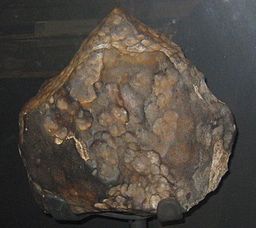Creation Corner
Water deep in mantle? Not so fast

Two days ago, geologists at the University of Alberta spoke publicly about a result years in making. They said they found, on the ground, a mineral others only guessed lies about 320 miles deep. They further said this mineral held water. They published their findings, and a letter explaining them, in the journal Nature.
The lurid headlines rang out almost at once. “Earth has a secret reservoir of water, say scientists!” screamed Agence France-Presse on March 12. The next day (March 13), Reuters had a more sober headline for its story: “Brazilian diamond hints at vast water reserve deep inside Earth.” Today (March 14), Livescience.com (via Fox News Channel) had this headline: “Rare diamond reveals Earth’s interior is all wet.”
Not so fast, says Walter T. Brown of the Center for Scientific Creation in Phoenix, Arizona. First, the mineral is rich in hydroxy groups. That doesn’t make it water-rich. Second, the mineral could as easily have formed during the “compression event” during the breakout of the subcrustal ocean that gave us the Global Flood.
A water-rich mineral?

The Tenham Meteorite, discovered in Queensland, Australia in 1879. One of several meteorites containing ringwoodite, a hydroxyl-rich mineral. Credit: User Chemical Engineer/Wikimedia Commons, CC BY-SA 3.0 Unported License
The finding causing all the excitement is a large brown diamond, itself of no commercial value. Brown diamonds are worth the least, and especially when they have flaws. In 2008, “amateur gem hunters,” digging in a shallow river bottom in Brazil, found such a diamond. For unclear reasons, the University of Alberta geologists asked for this diamond. That diamond became a graduate-student project. And the student involved found, in a microscopic flaw, a tiny amount of a rare mineral.
This mineral, a form of olivine, has the name ringwoodite, after Ted Ringwood. Dr. Ringwood supposed that high pressures and temperature in a zone 410 to 660 km deep would produce a form of olivine laden with hydroxyl groups. Since then, astrogeologists have found this mineral in meteorites. This is the first finding of this mineral on earth. For obvious reasons, no one has proposed drilling to such a depth, into the “transition zone” in the earth’s mantle.
Drs. Hans Keppler, D. G. Pearson, and their team cite this as proof positive that this “transition zone” is water-rich. They even say this zone holds more water than all the earth’s oceans combined.
A proper perspective
Last night this correspondent sought out Walter T. Brown, originator of the Hydroplate Theory, for his perspective. Brown immediately rejected the notion of a “secret reserve of water.”
This finding, and the hype surrounding it, illustrates the central problem of uniformitarian geologists: where did the Earth get all its water? They simply cannot explain that from the Nebula Theory of the formation of the solar system. There is no reason why the earth should have formed from accretion with all that water. So where does the water come from? It cannot come from comets, because comets have too much deuterium in them.
Brown refers here to a well-known fact about comets: they hold twice the concentration of deuterium, or “heavy hydrogen,” that one finds in the oceans of earth.
Concerning ringwoodite, Brown pointed out the obvious: hydroxyl groups are not the same as bound water molecules. To form such large amounts of water from the hydroxyl groups in the ringwoodite (assuming it really could be found), one would have to add equally large quantities of elemental hydrogen. No one has even thought about where that hydrogen might come from.
Brown’s Hydroplate Theory does mention an analog of the mantle transition zone. He calls it the crossover depth and defines it as that depth below which molten minerals are more dense, rather than less, than their solid states. Such melts drain into the outer core, instead of trying to force their way to the crust.
More to the point, Brown suggests another time this diamond with the microscopic ringwoodite inclusion might have formed. After the subcrustal ocean broke out and washed over the land masses, the continents drifted. (Plate tectonics also says the continents drifted. But the Hydroplate Theory says they drifted much faster.) Toward the end came a compression event that formed the mountain chains we see today. This page gives the details.
Brown adds this word of caution to his fellow creation advocates. They should not connect this finding with the Global Flood. The transition zone, according to conventional theory, lies 320 miles deep. The subcrustal ocean lay ten miles deep to the pre-Flood ground and was 0.75 mile deep on average.
Reprinted from examiner.com
[subscribe2]
Terry A. Hurlbut has been a student of politics, philosophy, and science for more than 35 years. He is a graduate of Yale College and has served as a physician-level laboratory administrator in a 250-bed community hospital. He also is a serious student of the Bible, is conversant in its two primary original languages, and has followed the creation-science movement closely since 1993.
-

 Civilization3 days ago
Civilization3 days agoDC Pipe Bomb Arrest Raises Questions About Christopher’s Wray’s FBI
-

 Civilization4 days ago
Civilization4 days agoThe Legal Logic Behind U.S. Operations Against Narco-Terrorist Networks
-

 Executive4 days ago
Executive4 days agoNewsom’s ‘National Model’ for Homeless Wracked by Fraud
-

 Executive3 days ago
Executive3 days agoWhen You’re in a Hole, Stop Digging
-

 Education3 days ago
Education3 days agoWaste of the Day: Taxpayers Subsidize Football Coach Severance
-

 Executive2 days ago
Executive2 days agoWaste of the Day: Obamacare Failed Test, Approved Fraudulent Subsidies
-

 Civilization2 days ago
Civilization2 days agoPence Calls on Trump To Fire RFK Jr Over Abortion Drug
-

 Executive4 days ago
Executive4 days agoWaste of the Day: Feds Pay Nonprofits That Sue the Government













[…] from examiner.com and […]
[…] Water deep in mantle? Not so fast […]